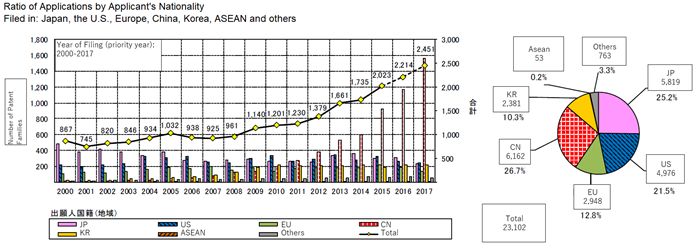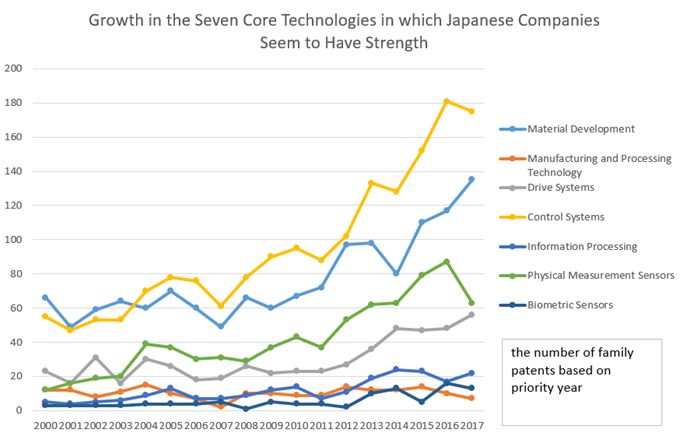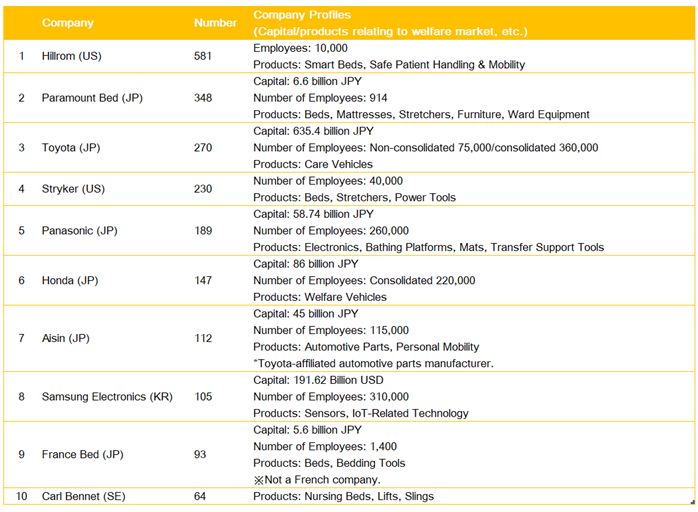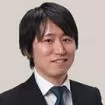The Japan Patent Office (JPO) annually publishes patent trend reports on ten promising technical areas that attract a high level of attention. In this article, we will summarize parts of the report on assistive devices that might be of interest to overseas companies, and report on the market trends as well.
At a Glance
The JPO report on assistive devices focuses on "nursing beds", "transfer assisting apparatuses" as nursing assisting apparatuses, "self-help tools for eating" and "walking assisting apparatuses" as independent life assisting apparatuses. It is notable that the JPO has uniquely analyzed core technologies of the above mentioned devices. For example, the core technologies in nursing beds and transfer assisting apparatuses include drive systems, control systems, designs, information processing, physical measurement sensors, biometric sensors and others. In the same way, the core technologies for self-help tools for eating, walking assisting apparatuses, and transfer assisting apparatuses, such as walking sticks are related to applied technologies such as material development, manufacturing/processing technologies and design.
In the report, approximately 70,000 patent/non-patent documents were classified into each technology category and the JPO analyzed the collected data based on the ranking of applicants and authors of academic papers in these technologies. The report also mentions the market trends and the environments for development. The JPO highlights the results of the survey as follows:
(1) As the population ages and the need of nursing care increases, the market for assistive devices is on the rise.
(2) Many measures to support the development of assistive device are enhancing the environments for R&D already in place.
(3) Regarding the ranking of applicants filing the relevant technologies to the JPO, Japanese companies are ranked high on the list. However, please be informed that there has been a remarkable increase in the number of applications by Chinese companies in recent years.

(4) In terms of the number of academic papers, the ratio of presentations by Japanese researchers is high, and many of them are related to walking assisting apparatuses.
Market Growth
Japan has become well-known for its aging society, which is frequently a topic of media coverage. Likewise, it is already recognized that an aging society is becoming a major issue among all developed countries. In fact, the global market for assistive devices is growing as shown below and is expected to continue growing in years to come. This market expansion is not limited to a specific region, and so, without any doubt, the dire demand for assistive devices in response to this societal issue will increase around the world.

Measures to Support Development
In addition to the growing demands for assistive device in aging society, it is also indispensable in assisting people with disabilities. Various countries have implemented measures to protect people with disabilities and to bolster the development of assistive devices. In Japan, several regulations concerning quality of life among people with disabilities were established in the 2010s. Under such circumstances, there have been high expectations for the advancement of research and development of assistive devices and their further dissemination. In recent years, assistive devices have also been mentioned as one of the fields that need to utilize robotic technology. In terms of research and development, the Japan Agency for Medical Research and Development (AMED) is implementing the following projects.
- Project for assisting the development and standardization of robotic nursing equipment.
- Project for assisting the development and promotion of robotic nursing equipment
- Comprehensive research and development project on measures for people with disabilities, etc.
In Europe, as part of the European Disability Strategy 2010-2020, it was announced that funding for research and development using ICT to help people with disabilities and for pilot projects to develop technological solutions to promote independence were implemented in 2017.
In China, there is mention in the national plan of policies relating to the welfare of the elderly stating that they will make efforts to open up and expand the relevant market.
In this way, the market of assistive devices is being boosted by various governments around the world, and incubation for further development is being actively created.
Filing Trends and Rankings of Major Companies
The total number of applications related to assistive devices filed to Japan, the U.S., Europe, China, Korea and the ASEAN countries is 23,102 cases (2000-2017). Chinese applicants account for 26.7%, followed by Japanese (25.2%), the U.S. (21.5%), and European nationalities (12.8%). Applicants in Japan, the U.S., Europe, China, and South Korea each filed the largest number of applications in their home countries.

The core technology areas in which Japanese applicants occupy 30% or more in the ratio are "material development", "manufacturing and processing technology", "drive systems", "control systems", "information processing", "physical measurement sensors" and "biometric sensors". Japanese companies have a technological competitive edge in these seven areas. The graph below shows the number of patent applications of these seven core technologies. In particular, control systems and material development continue to show significant growth.

Although Chinese companies ranked at first place in the pie chart of applicants' nationality, the following ranking shows that many Japanese companies are listed in the top ten filers. In the production of assistive device, it is expected that a wide variety of products is to be produced in small quantities to cater to individual needs. Therefore, small and medium-sized companies (SMEs)/start-ups are expected to venture into the market. In other words, they will file applications to the country which they venture into. In this sense, the future filing trends cannot be predicted only by applications filed by large companies. This can be said to be a unique characteristic of the assistive device market.

On the other hand, state-of-the-art assistive devices applying new technologies to conventional equipment (e.g. electric wheelchairs linked to GPS, nursing beds using sensors, etc.) have been developed in recent years. However, it is presumed that the consideration and establishment of standards for these new technologies have not sufficiently kept up with the demands in these major countries.
Summary
As mentioned above, products that meet diverse needs are expected in the assistive device market. It is important for developers to grasp the needs of users and to appropriately link them with seeds of new technology. Finally, we would like to introduce the following three suggestions from the JPO. These could have an impact on corporate research strategies.
(1) The development of assistive devices aimed at offsetting the burden on caregivers and addressing the shortage of human resources is an urgent issue.
(2) It is necessary to develop assistive devices which allow elderly people and/or care recipients to maintain their independence and improve quality of life in order to prevent them from becoming bedridden even when they need nursing care.
*In particular, walking assisting apparatuses and self-help tools for eating should be safe, easy to operate, equipped with functions and designs that make the elderly wiling to use them. Additionally, tools should be developed to meet a variety of needs in order to encourage their users to have social participation and to stay independent through enjoying themselves, such as encouraging willingness for outings and dietary improvements.
(3) In a bid to facilitate tapping overseas potential markets, such as China and ASEAN, measures should be taken to encourage SMEs and start-ups to enter the market, as well as to promote the international expansion of Japanese companies.
Reference: Survey Results of the Patent Applications and Technology Trend, etc., FY 2019 (Japanese Only) (Japan Patent Office)
https://www.meti.go.jp/press/2020/04/20200430003/20200430003-1.pdf
The content of this article is intended to provide a general guide to the subject matter. Specialist advice should be sought about your specific circumstances.
